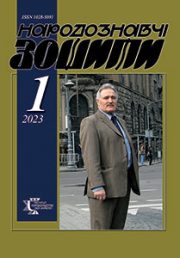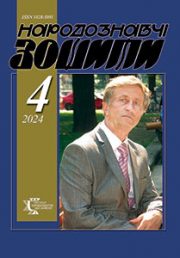The Ethnology Notebooks. 2021. # 2 (158), P. 355—366
УДК [39:[613:911.379]](477.83)”18/19″
DOI https://doi.org/10.15407/nz2021.02.355
Маrіa HORBAL
ORCID ID: https://orcid.org/0000-0001-9287-8336
- Leading Scientific Editor,
- The Institute of Ethnology of the National
- Academy of Sciences of Ukraine,
- 15, Svobody Avenue, 79000, Lviv, Ukraine,
- e-mail:horbal.m@gmail.com
Problem statement. Knowledge of folk sanitation and hygiene of life in rural areas were formed for many centuries to protect people’s health, prevention of their illnesses, ensuring their proper life. This knowledge was treated with material culture: agriculture, livestock, arts and crafts, domestic life, construction, interior of buildings, clothing, meals and were transferred from generation to generation, provided rational use of water and land, contributed to harmonious co-operation with plant and animal world.
The purpose of our article is to analyze sanitation and hygiene in the everyday life of the peasants of one village – Selysko in Lviv region (now Pustomyty district), namely: in the mansion, on a planting site and in rural environments.
The research is based mainly on the memoirs of the villagers recorded at different times that reproduced the memories of their ancestors, and therefore the coverage of the topic has a purely local character, but it is operated on the tradition of the Galician region.
Today, residents of the village lost in everyday life a significant number of hygienic and sanitary guidelines related to the farmsteads and the private plot, the rural environment, which were inherent from their ancestors. At the end, with a change in lifestyle changed the lives themselves that are directed to the protection of own and public health and cultural accommodation. However, the reconstruction of historical memory is an invaluable treasure for a modern and future generation, what is the relevance of the chosen topic. We must also mention the novelty of the article.
Chronological limits of research XIX — second half of XX century.
Theoretical and methodological basis for writing the article were the works of Ukrainian ethnographers: Y. Taras, V. Galaychuk, R. Guziy, R. Siletsky, R. Radovich, etc.
The research methods are chosen by the principle of systemicity, a method of historical reconstruction and a contextual method. At the stage of collection and systematization of primary information – methods of interviewing and photofixation.
Key words: village, lives of peasants, farmstead, planting plot, rural environment, water sources.
REFERENCES
- Taras, Ya. (2016). Folk ecology and hygiene on Polissya (according to the materials of expeditions in 1994—2003). The Ethnology notebooks. № 2. P. 333—340 [in Ukrainian].
- Horbalʹ M. (2020). Census of population and its property in Selisko village, Lviv region of 1940—1941 and 1950. The Ethnology notebooks. № 4. P. 960—995 [in Ukrainian].
- Fedaka P. (2006). Formation of mountain settlements. Ethnogenesis and ethnic history of the population of the Ukrainian Carpathians. Т. ІІ. Ethnology and art history. Lviv: Institute of Ethnology of the National Academy of Sciences of Ukraine. P. 141—161 [in Ukrainian].
- Meters of snow in height: what was the winter in Lviv in 1929:
- https://lviv1256.com/history/yak-vzimku-1929-roku-koliyu-lviv-ternopil-rozchyschaly/?fbclid=IwAR3I28tpeEeKlO5sP_4lXjFYfFILmklNQjhlwi6XkHhGpkvDtnMzz_TBCXY [in Ukrainian].
- (1929). «Dіlо». February 14 [in Ukrainian].







